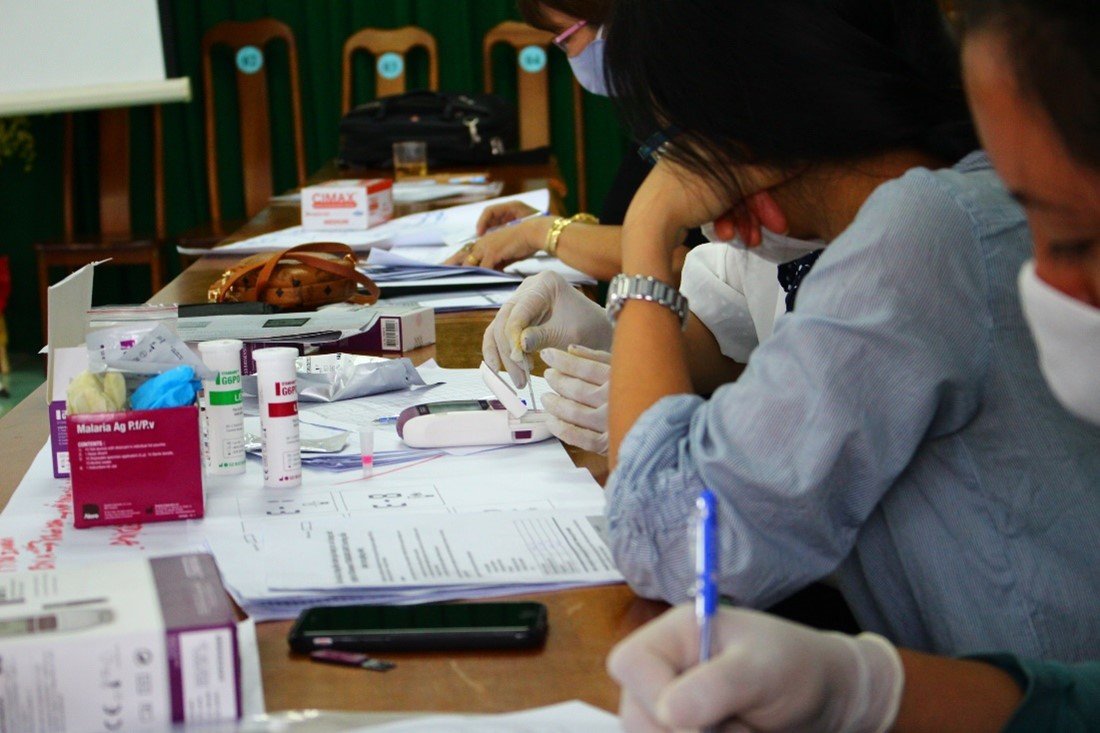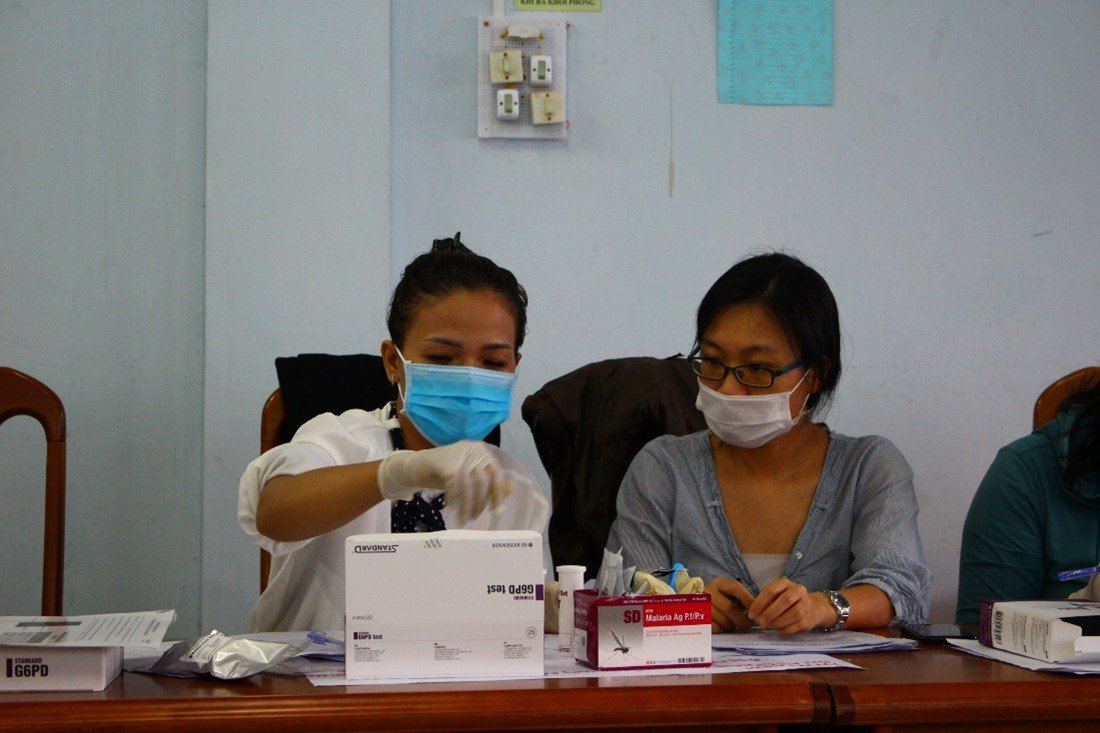Malaria infects and adversely impacts millions of people every year. About 2.5 billion people in Asia, Latin America, and the horn of Africa are at risk of infection from P. vivax, the most geographically widespread malaria parasite. Yet, services and products that improve testing and treatment for P. vivax are not as widely available as they need to be to achieve malaria eradication goals. That is why PATH’s Market Dynamics team and our partner Medicines for Malaria Venture (MMV) are working together through the Partnership for Vivax Elimination (PAVE) to ensure diagnostic tests and appropriate treatments reach the people who need them.
A key element of our malaria work is strengthening markets so diagnostic and treatment products are affordable, high quality, and appropriately designed for their locations of use and that they reach the health care providers and patients who need them. As part of PAVE, PATH, MMV and our implementing partners—Global Health Strategies, Clinton Health Access Initiative, and Population Services International—support key decision-makers and leaders of ministries of health, national malaria programs (NMPs), and the World Health Organization (WHO) to increase availability and access of P. vivax malaria products.

Huyen Nguyen, from PATH, provides training at a health center in Ayun Pa, Vietnam to a healthcare worker participating in a study on G6PD diagnostics. Photo credit: Spike Novak.
1. Understanding the problem and opportunities
P. vivax can lie dormant in the liver, hidden from standard antimalarial medicines, for weeks or months after infection. If a patient relapses, they become infectious, increasing the risk of transmission throughout their community. Two separate types of drugs can achieve complete “radical cure”—the elimination of P. vivax parasites in a patient’s blood and liver. But for 400 million people worldwide who are deficient in glucose-6-phosphate dehydrogenase (G6PD; an enzyme that protects red blood cells) the types of drugs that target P. vivax in the liver solve one problem while potentially creating another: hemolytic anemia. And that is why WHO recommends G6PD testing to guide the use of liver-stage P. vivax drugs. Although high-quality G6PD tests and treatments exist, the tests are not widely available and current treatments often take at least two weeks, making widespread treatment of the disease and malaria eradication difficult.
Before PAVE could support NMPs in getting malaria diagnostics and medicines to the people who need them, PATH had to better understand the perspectives of NMPs and other stakeholders on the needs, challenges, and opportunities in front of them. So, we identified stakeholders in more than 15 countries on three continents to assess how the different public health systems functioned, investigated malaria service provision within each health system, and gained perspectives on the perceptions of new products. The team then went a step further, engaging local stakeholders on supply chains, procurement processes, and distribution channels, so we could understand the opportunities and barriers to expanding access to new diagnostic tests and treatments.
2. Building on our learnings
Using what we learned, PATH moved into the next step in our process. With ministry of health representatives, we co-created country-specific strategies that identified the ways in which NMPs, ministries of health, and other stakeholders can build consensus around appropriate and effective solutions for enhancing the availability of malaria diagnostics and medicines. PATH also developed a road map for regulatory approvals, policy adoption, timelines, funding, and distribution to health facilities and patients.
“In Peru, we built trust by sharing our global evidence on new malaria diagnostics and medicines once we ensured commitment from the Ministry of Health. Then we promoted our progress and developed sharing opportunities for implementation in other countries within the region,” says Ines Contreras, PAVE Co-Country Coordinator, Peru. “This strategic support enabled us to link diverse stakeholders who support our work and address barriers we encountered during the initial assessment.”
3. Contextualizing launch plans
Countries are unique and require unique plans that increase access as much as possible for malaria products and services. We work in countries that are in different stages of their malaria journeys, from control to elimination, and have different health systems and ways of delivering care. Each country selects the most appropriate tools and leads its own integration of these tools based on its specific needs and health care ecosystem, with PATH providing technical support.
“Although geographically close, countries in the Greater Mekong Subregion have very different P. vivax burdens, health systems, and priorities, which result in unique needs for each country. Due to a high prevalence of G6PD deficiency in Cambodia and Lao PDR, NMPs in these countries prioritized adopting G6PD testing quickly, so PAVE focused on supporting the introduction of quantitative G6PD diagnostics,” says Spike Nowak, Market Dynamics Program Officer and PAVE Regional Advisor. “However, in nearby Myanmar, G6PD deficiency was not as high of a priority but adherence to the 14-day liver-stage treatment was, so the PAVE project first focused on developing tools to increase treatment adherence and practices to improve patient counseling on potential adverse events.”
In each country, PATH and country partners co-designed a unique launch plan highlighting the evidence for policy change, product registration processes, demand estimations, and the case for integrating these products into existing health financing budgets. Depending on a country’s specific needs, these plans could include pilot implementation studies of new diagnostic tools and treatment regimens. Based on those findings, countries can adopt policies for introduction and identify the roles and responsibilities of key stakeholders.
4. Moving from procurement to service provision
After the assessments, strategy creation, and launch, PATH supported the adoption, introduction, distribution, and delivery of P. vivax products and the training of health care personnel on these products. The goal of this phase was for new radical cure tools to establish a route to sustainable integration into the health system.
Findings and training materials from a G6PD diagnostic feasibility study funded by the UK Foreign, Commonwealth & Development Office and jointly run by PATH and Vietnam’s NMP supported G6PD diagnostic use for the first time in routine settings outside of a study. PATH provided technical assistance to our partner Health Poverty Action to roll out G6PD testing on a small scale, in about 30 health facilities in areas with high P. vivax malaria burdens. With support from The Global Fund to Fight AIDS, Tuberculosis and Malaria, PATH used findings from the feasibility study to develop training materials and conduct trainings. We also provided supportive supervision tools and a supportive supervision strategy that fit within the country’s context.

A study participant in Vietnam learns to use the G6PD test. The study would inform whether the test could eventually be adopted into routine care. Photo credit: Spike Novak.
“In Vietnam, the product entry phase started with the implementation of G6PD testing in 30 health facilities with a high P. vivax burden. PATH supported the NMP to develop the training materials and conduct trainings based on feasibility study learnings, and then we supported the NMP to develop the supportive supervision tools and strategy tailored to the context in Vietnam," says Huyen Nguyen Thanh, PATH’s Malaria Team Leader in Vietnam. “When applying any new test, frequent supportive supervision is very important to ensure the health care workers remember how to run the test properly and identify and solve any issues that may arise.”
5. Reaching more people with the tools they need
The fifth—and final—step in this process is scaling up so that more diagnostic tools and medicines reach more people, based on each country’s burden of P. vivax and the guidelines set out by the NMP and WHO. It requires taking the lessons learned from the previous phases, building on the solutions identified, and continuing the momentum for countrywide adoption, scale, and sustainable impact.
The promise of stronger markets
Our program’s vision is a world free from P. vivax malaria: one in which the global community and partner countries have the tools and resources they need to control and eliminate malaria. PATH and our partners are working to ensure that increased access and ready markets are part of the solution. By working with country governments to support achievement of shared goals, our integrated approach leads to stronger, more efficient markets—clearing the way for greater health and well-being for more people and communities.


